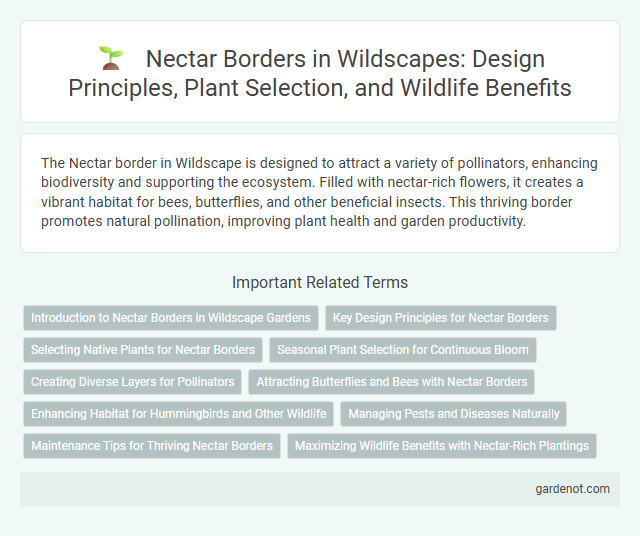The Nectar border in Wildscape is designed to attract a variety of pollinators, enhancing biodiversity and supporting the ecosystem. Filled with nectar-rich flowers, it creates a vibrant habitat for bees, butterflies, and other beneficial insects. This thriving border promotes natural pollination, improving plant health and garden productivity.
Introduction to Nectar Borders in Wildscape Gardens
Nectar borders in Wildscape gardens serve as vibrant habitats designed to attract and support a diverse range of pollinators, including bees, butterflies, and hummingbirds. These carefully curated plantings feature nectar-rich flowers like milkweed, coneflowers, and bee balm that provide essential food resources throughout the growing season. Incorporating nectar borders enhances biodiversity, promotes pollination, and supports ecological balance within garden ecosystems.
Key Design Principles for Nectar Borders
Nectar borders in wildscaping prioritize biodiversity by incorporating a diverse range of nectar-rich plants that bloom sequentially to provide continuous food for pollinators throughout the seasons. Design principles emphasize native plant selection, layering plant heights for accessibility, and creating microhabitats to support various insect species. Strategic placement near habitat corridors enhances pollinator movement and ecosystem connectivity.
Selecting Native Plants for Nectar Borders
Selecting native plants for nectar borders enhances local biodiversity by providing essential food sources for pollinators like bees and butterflies. Species such as Echinacea purpurea, Asclepias tuberosa, and Monarda didyma thrive in wildscape environments and offer abundant nectar throughout the growing season. Incorporating a diverse mix of native flora ensures continuous bloom succession, supporting pollinator health and ecosystem resilience.
Seasonal Plant Selection for Continuous Bloom
Nectar borders feature a strategic seasonal plant selection to ensure continuous bloom and a steady supply of nectar for pollinators throughout the year. Early spring bulbs like crocus and snowdrops initiate nectar flow, followed by late spring perennials such as lavender and catmint. Summer bloomers including echinacea and bee balm sustain nectar availability, while autumnal asters and sedums extend forage into the cooler months.
Creating Diverse Layers for Pollinators
Nectar borders play a crucial role in creating diverse layers of flowering plants that attract a wide range of pollinators such as bees, butterflies, and hoverflies. Incorporating native wildflowers with staggered bloom times ensures continuous nectar sources throughout the growing season, supporting pollinator health and biodiversity. Strategic planting in varied heights and densities enhances habitat complexity, encouraging higher pollinator visitation and promoting ecosystem resilience.
Attracting Butterflies and Bees with Nectar Borders
Nectar borders planted with native flowering plants create an essential habitat for pollinators by providing a continuous source of nectar throughout the growing season. Species like lavender, coneflower, and butterfly bush specifically attract butterflies and bees, enhancing biodiversity in a wildscape environment. These nectar-rich borders support ecosystem health by encouraging pollination and sustaining local insect populations.
Enhancing Habitat for Hummingbirds and Other Wildlife
Nectar borders planted with native wildflowers and nectar-rich plants create an essential habitat for hummingbirds and other pollinators by providing a continuous food source throughout the seasons. These vibrant borders support biodiversity by attracting a variety of species, including bees, butterflies, and small birds, fostering ecological balance. Incorporating nectar borders within wildscapes enhances local ecosystems, promoting wildlife conservation and natural plant pollination.
Managing Pests and Diseases Naturally
Nectar border gardens attract beneficial insects like ladybugs and lacewings that naturally control aphids and other harmful pests, reducing the need for chemical pesticides. Planting diverse native flowers supports pollinator health and enhances ecosystem resilience against diseases. Regular monitoring and companion planting promote a balanced environment, minimizing outbreaks and maintaining vibrant, healthy wildscapes.
Maintenance Tips for Thriving Nectar Borders
Regular watering and soil enrichment are essential to maintain vibrant nectar borders, ensuring blooms attract pollinators effectively. Pruning spent flowers and removing weeds prevent nutrient competition and promote prolonged flowering in nectar-rich plants. Incorporating native pollinator-friendly species enhances the ecological balance and supports the natural lifecycle of butterflies and bees within the wildscape.
Maximizing Wildlife Benefits with Nectar-Rich Plantings
Nectar borders planted with a diverse array of native, nectar-rich flowers significantly enhance pollinator activity by providing essential food sources for bees, butterflies, and other insects. Strategic placement of flowering plants with staggered bloom times maximizes continuous nectar availability throughout the growing season, supporting wildlife biodiversity and ecosystem health. Incorporating species such as Echinacea, Buddleja, and Phacelia in nectar borders creates effective habitats that promote pollination and bolster local food webs in wildscapes.
Nectar border Infographic

 gardenot.com
gardenot.com